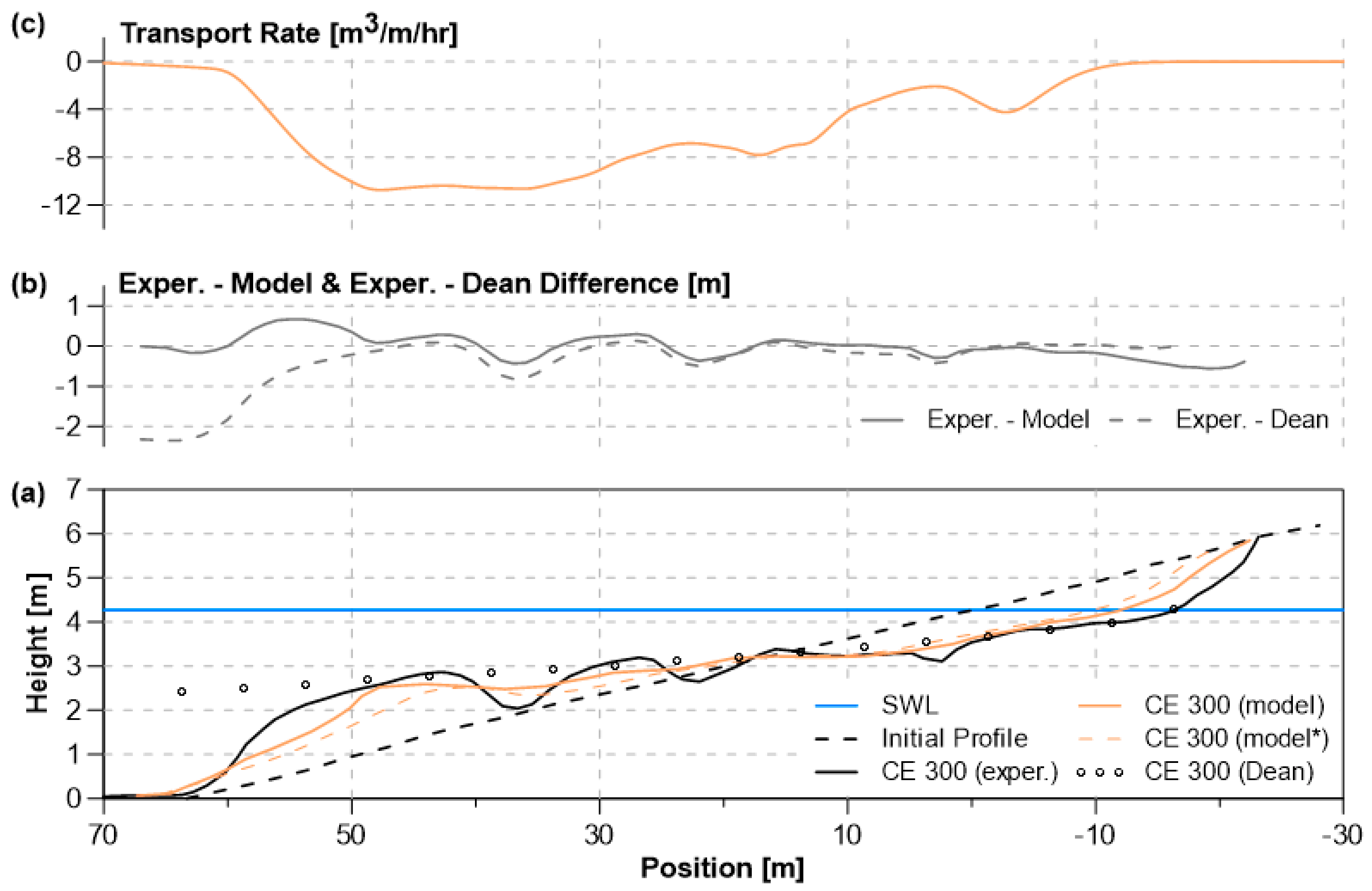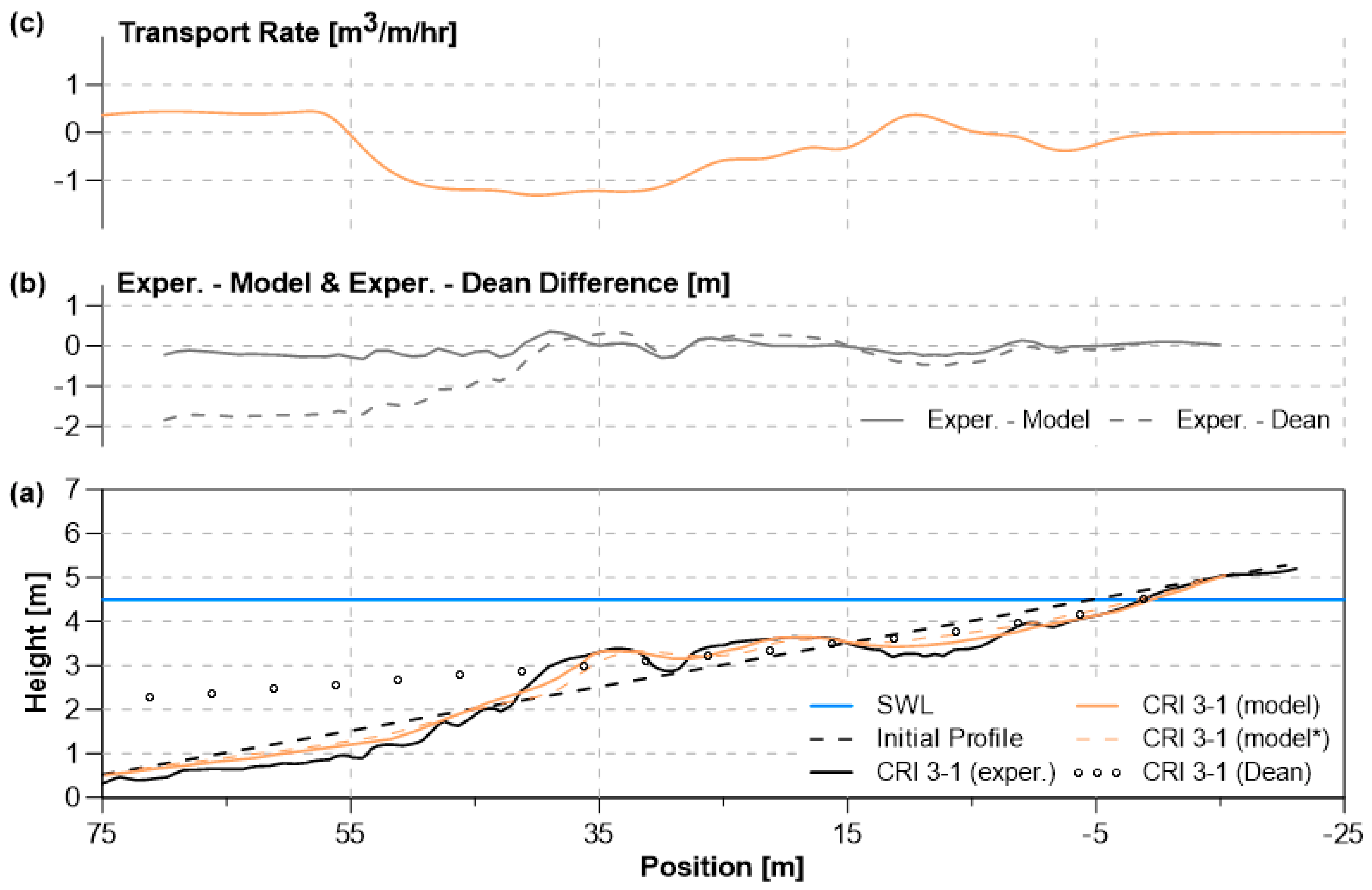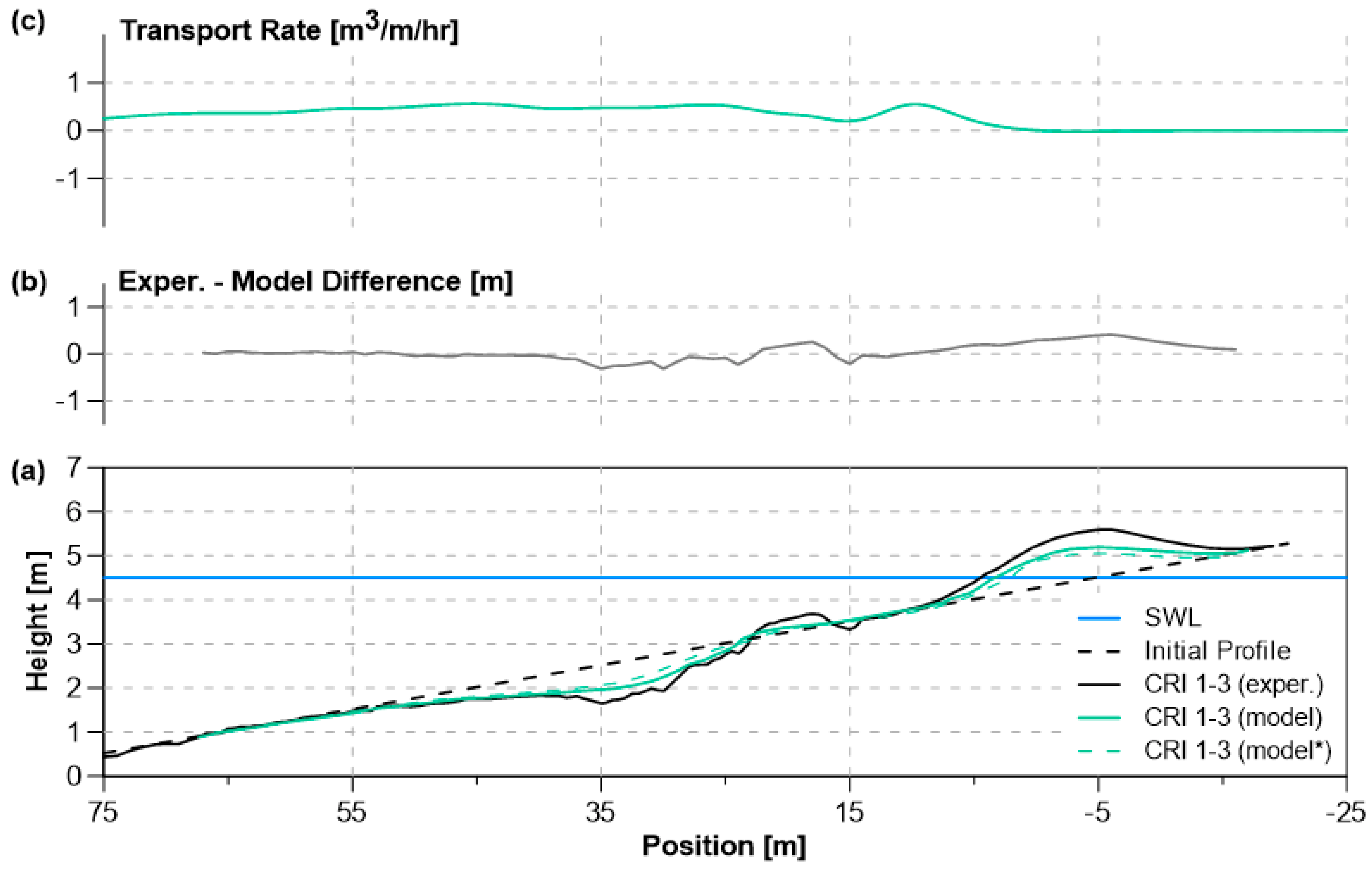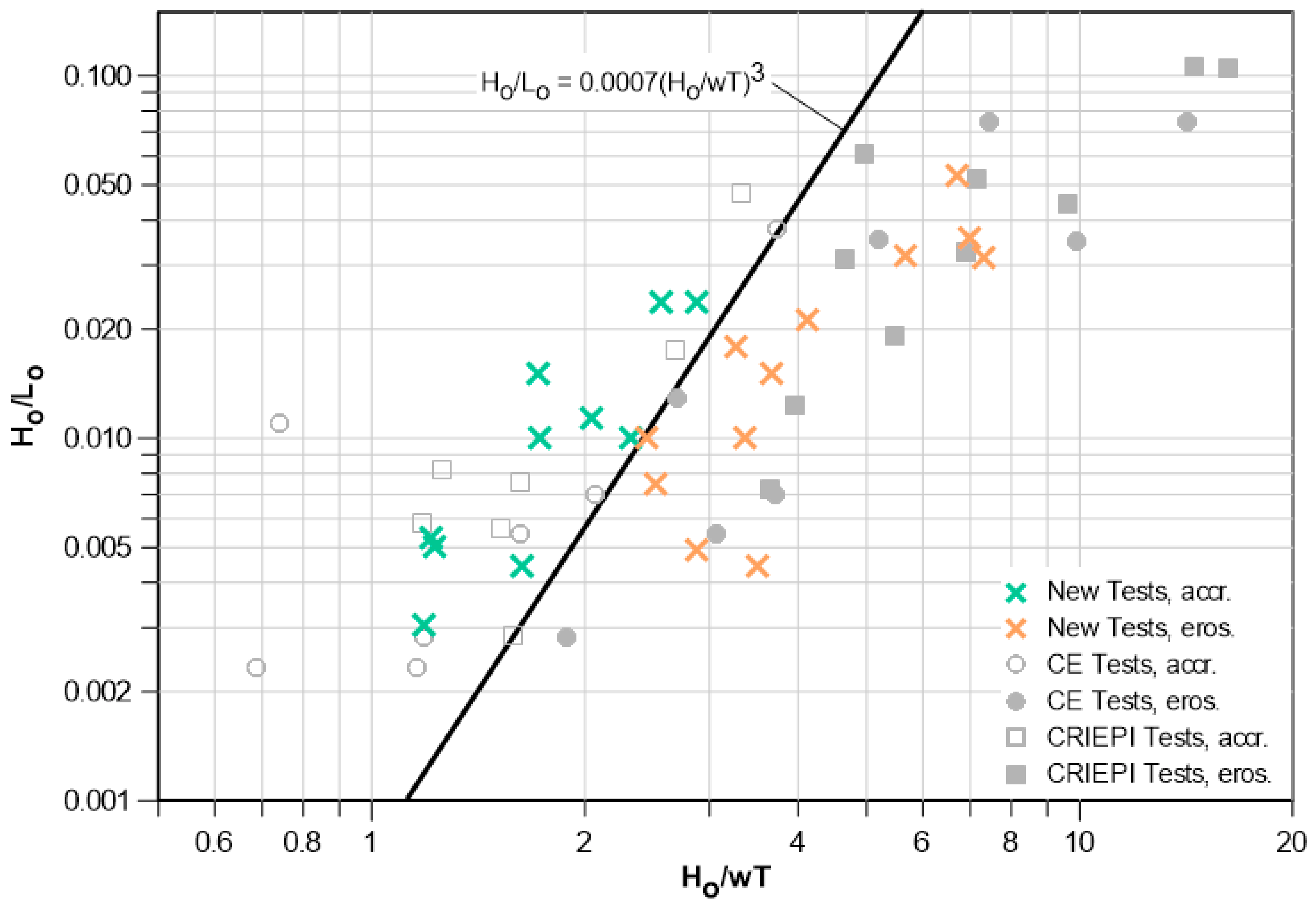Simulating Erosive and Accretive Conditions in the Swash: Applications of a Nonlinear Wave and Morphology Evolution Model
Abstract
:1. Introduction
2. The Wave and Morphology Evolution Model
3. Model Applications
3.1. Validation for Experimental Data
3.2. Investigation of an Erosion/Accretion Criterion
4. Results and Discussion
4.1. Results for Model Validation
4.2. Results for the Investigation of an Erosion/Accretion Criterion
5. Conclusions
Author Contributions
Funding
Institutional Review Board Statement
Informed Consent Statement
Data Availability Statement
Conflicts of Interest
References
- Gao, W.; Liu, J.; Xu, Y.; Li, P. Evolution of sandy shores under the combined impact of global climate change and anthropogenic activities in Shandong Peninsula, East China. J. Asian Earth Sci. 2024, 259, 105887. [Google Scholar] [CrossRef]
- Leal, K.B.; Robaina, L.E.d.S.; De Lima, A.d.S. Coastal impacts of storm surges on a changing climate: A global bibliometric analysis. Nat. Hazards 2022, 114, 1455–1476. [Google Scholar] [CrossRef]
- Lobeto, H.; Menendez, M.; Losada, I.J. Future behavior of wind wave extremes due to climate change. Sci. Rep. 2021, 11, 7869. [Google Scholar] [CrossRef] [PubMed]
- Flor-Blanco, G.; Alcántara-Carrió, J.; Jackson, D.W.T.; Flor, G.; Flores-Soriano, C. Coastal erosion in NW Spain: Recent patterns under extreme storm wave events. Geomorphology 2021, 387, 107767. [Google Scholar] [CrossRef]
- Toimil, A.; Camus, P.; Losada, I.J.; Le Cozannet, G.; Nicholls, R.J.; Idier, D.; Maspataud, A. Climate change-driven coastal erosion modelling in temperate sandy beaches: Methods and uncertainty treatment. Earth Sci. Rev. 2020, 202, 103110. [Google Scholar] [CrossRef]
- Mentaschi, L.; Vousdoukas, M.I.; Voukouvalas, E.; Dosio, A.; Feyen, L. Global changes of extreme coastal wave energy fluxes triggered by intensified teleconnection patterns. Geophys. Res. Lett. 2017, 44, 2416–2426. [Google Scholar] [CrossRef]
- Kirezci, E.; Young, I.R.; Ranasinghe, R.; Muis, S.; Nicholls, R.J.; Lincke, D.; Hinkel, J. Projections of global-scale extreme sea levels and resulting episodic coastal flooding over the 21st Century. Sci. Rep. 2020, 10, 11629. [Google Scholar] [CrossRef]
- Han, X.; Kuang, C.; Zhu, L.; Gong, L.; Cong, X. Hydrodynamical and morphological patterns of a sandy coast with a beach nourishment suffering from a storm surge. Coast Eng. J. 2022, 64, 83–99. [Google Scholar] [CrossRef]
- Cueto, J.E.; Otero Díaz, L.J.; Ospino-Ortiz, S.R.; Torres-Freyermuth, A. The role of morphodynamics in predicting coastal flooding from storms on a dissipative beach with sea level rise conditions. Nat. Hazards Earth Syst. Sci. 2022, 22, 713–728. [Google Scholar] [CrossRef]
- Postacchini, M.; Melito, L.; Ludeno, G. Nearshore Observations and Modeling: Synergy for Coastal Flooding Prediction. J. Mar. Sci. Eng. 2023, 11, 1504. [Google Scholar] [CrossRef]
- IPCC. Climate Change 2022: Impacts, Adaptation and Vulnerability; Contribution of Working Group II to the Sixth Assessment Report of the Intergovernmental Panel on Climate Change; IPCC: Cambridge, UK; New York, NY, USA, 2022; p. 3056. [Google Scholar]
- IPCC. Climate Change 2022: Mitigation of Climate Change; Working Group III Contribution to the Sixth Assessment Report of the Intergovernmental Panel on Climate Change; IPCC: Cambridge, UK; New York, NY, USA, 2022; p. 1991. [Google Scholar]
- Karambas, T.V.; Samaras, A.G. Soft shore protection methods: The use of advanced numerical models in the evaluation of beach nourishment. Ocean Eng. 2014, 92, 129–136. [Google Scholar] [CrossRef]
- Postacchini, M.; Russo, A.; Carniel, S.; Brocchini, M. Assessing the Hydro-Morphodynamic Response of a Beach Protected by Detached, Impermeable, Submerged Breakwaters: A Numerical Approach. J. Coast. Res. 2016, 32, 590–602. [Google Scholar]
- Karambas, T.V.; Samaras, A.G. An Integrated Numerical Model for the Design of Coastal Protection Structures. J. Mar. Sci. Eng. 2017, 5, 50. [Google Scholar] [CrossRef]
- Samaras, A.G.; Karambas, T.V. Modelling the Impact of Climate Change on Coastal Flooding: Implications for Coastal Structures Design. J. Mar. Sci. Eng. 2021, 9, 1008. [Google Scholar] [CrossRef]
- Mohapatra, S.C.; Fonseca, R.; Guedes Soares, C. A comparison between analytical and numerical simulations of solutions of the coupled Boussinesq equations. In Maritime Technology and Engineering 3; Guedes Soares, C., Santos, T.A., Eds.; Taylor & Francis Group: Abingdon, UK, 2016; pp. 1175–1180. [Google Scholar]
- Mohapatra, S.C.; Guedes Soares, C. Shallow water hydrodynamics: Comparing solutions of the coupled Boussinesq equations in shallow water. In Maritime Technology and Engineering; Guedes Soares, C., Santos, T.A., Eds.; CRC Press: Boca Raton, FL, USA, 2014; p. 8. [Google Scholar]
- Anthony, E.J. Wave influence in the construction, shaping and destruction of river deltas: A review. Mar. Geol. 2015, 361, 53–78. [Google Scholar] [CrossRef]
- Samaras, A.G. Towards integrated modelling of Watershed-Coast System morphodynamics in a changing climate: A critical review and the path forward. Sci. Total Environ. 2023, 882, 163625. [Google Scholar] [CrossRef]
- French, J.; Payo, A.; Murray, B.; Orford, J.; Eliot, M.; Cowell, P. Appropriate complexity for the prediction of coastal and estuarine geomorphic behaviour at decadal to centennial scales. Geomorphology 2016, 256, 3–16. [Google Scholar] [CrossRef]
- Nicholls, R.J.; French, J.R.; van Maanen, B. Simulating decadal coastal morphodynamics. Geomorphology 2016, 256, 1–2. [Google Scholar] [CrossRef]
- Van Maanen, B.; Nicholls, R.J.; French, J.R.; Barkwith, A.; Bonaldo, D.; Burningham, H.; Brad Murray, A.; Payo, A.; Sutherland, J.; Thornhill, G.; et al. Simulating mesoscale coastal evolution for decadal coastal management: A new framework integrating multiple, complementary modelling approaches. Geomorphology 2016, 256, 68–80. [Google Scholar] [CrossRef]
- Zhou, Z.; Coco, G.; Townend, I.; Olabarrieta, M.; van der Wegen, M.; Gong, Z.; D’Alpaos, A.; Gao, S.; Jaffe, B.E.; Gelfenbaum, G.; et al. Is “Morphodynamic Equilibrium” an oxymoron? Earth-Sci. Rev. 2017, 165, 257–267. [Google Scholar] [CrossRef]
- Ranasinghe, R. On the need for a new generation of coastal change models for the 21st century. Sci. Rep. 2020, 10, 2010. [Google Scholar] [CrossRef] [PubMed]
- Bayındır, C.; Farazande, S. The solution of the long-wave equation for various nonlinear depth and breadth profiles in the power-law form. Dyn. Atmos. Ocean. 2021, 96, 101254. [Google Scholar] [CrossRef]
- Jiang, A.W.; Hughes, M.; Cowell, P.; Gordon, A.; Savioli, J.C.; Ranasinghe, R. A hybrid model of swash-zone longshore sediment transport on reflective beaches. In Proceedings of the 32nd International Conference on Coastal Engineering, Shanghai, China, 30 June–5 July 2010. [Google Scholar] [CrossRef]
- Kamphuis, J.W. Alongshore sediment transport rate. J. Waterw. Port Coast. Ocean. Eng. 1991, 117, 624–640. [Google Scholar] [CrossRef]
- Kamphuis, J.W. Alongshore Transport Rate of Sand. In Proceedings of the 28th International Conference on Coastal Engineering, Cardiff, Wales, 7–12 July 2002; World Scientific: Wales, UK, 2003; pp. 2478–2490. [Google Scholar]
- Larson, M.; Wamsley, T.V. A Formula for Longshore Sediment Transport in the Swash. In Coastal Sediments ’07; ASCE Library: Reston, VA, USA, 2007; pp. 1924–1937. [Google Scholar]
- Samaras, A.G.; Karambas, T.V. On the simulation of longshore sediment transport in the swash zone in linear wave models. In Proceedings of the 7th IAHR Europe Congress, Athens, Greece, 7–9 September 2022; pp. 112–113. [Google Scholar]
- Chen, W.; van der Werf, J.J.; Hulscher, S.J.M.H. A review of practical models of sand transport in the swash zone. Earth-Sci. Rev. 2023, 238, 104355. [Google Scholar] [CrossRef]
- Deng, B.; Zhang, W.; Tang, H.S.; Jiang, C.B.; Liu, X.J. An experimental study on hydrodynamic process, beach profile, and sand migration in swash zone under action of dam-break bore. Appl. Ocean Res. 2022, 129, 103391. [Google Scholar] [CrossRef]
- Pontiki, M.; Puleo, J.A.; Bond, H.; Wengrove, M.; Feagin, R.A.; Hsu, T.J.; Huff, T. Geomorphic Response of a Coastal Berm to Storm Surge and the Importance of Sheet Flow Dynamics. J. Geophys. Res. F Earth Surf. 2023, 128, e2022JF006948. [Google Scholar] [CrossRef]
- Briganti, R.; Torres-Freyermuth, A.; Baldock, T.E.; Brocchini, M.; Dodd, N.; Hsu, T.J.; Jiang, Z.; Kim, Y.; Pintado-Patiño, J.C.; Postacchini, M. Advances in numerical modelling of swash zone dynamics. Coast. Eng. 2016, 115, 26–41. [Google Scholar] [CrossRef]
- Postacchini, M.; Othman, I.K.; Brocchini, M.; Baldock, T.E. Sediment transport and morphodynamics generated by a dam-break swash uprush: Coupled vs uncoupled modeling. Coast. Eng. 2014, 89, 99–105. [Google Scholar] [CrossRef]
- Tazaki, T.; Harada, E.; Gotoh, H. Numerical investigation of sediment transport mechanism under breaking waves by DEM-MPS coupling scheme. Coast. Eng. 2022, 175, 104146. [Google Scholar] [CrossRef]
- Pinault, J.; Morichon, D.; Delpey, M.; Roeber, V. Field observations and numerical modeling of swash motions at an engineered embayed beach under moderate to energetic conditions. Estuarine Coast. Shelf. Sci. 2022, 279, 108143. [Google Scholar] [CrossRef]
- Spyrou, D.; Karambas, T.V. Experimental and numerical simulation of cross-shore morphological processes in a nourished beach. J. Coast. Res. 2021, 37, 1012–1024. [Google Scholar] [CrossRef]
- Dette, H.H.; Larson, M.; Murphy, J.; Newe, J.; Peters, K.; Reniers, A.; Steetzel, H. Application of prototype flume tests for beach nourishment assessment. Coast. Eng. 2002, 47, 137–177. [Google Scholar] [CrossRef]
- Zhang, J.; Larson, M. A Numerical Model for Offshore Mound Evolution. J. Mar. Sci. Eng. 2020, 8, 160. [Google Scholar] [CrossRef]
- Kobayashi, N.; Agarwal, A.; Johnson, B.D. Longshore current and sediment transport on beaches. J. Water Port Coast. Ocean. Eng. 2007, 133, 296–304. [Google Scholar] [CrossRef]
- Karambas, T.V.; Karathanassi, E.K. Longshore sediment transport by nonlinear waves and currents. J. Water Port Coast. Ocean. Eng. 2004, 130, 277–286. [Google Scholar] [CrossRef]
- Schäffer, H.A.; Madsen, P.A.; Deigaard, R. A Boussinesq model for waves breaking in shallow water. Coast. Eng. 1993, 20, 185–202. [Google Scholar] [CrossRef]
- Chen, Q.; Dalrymple, R.A.; Kirby, J.T.; Kennedy, A.B.; Haller, M.C. Boussinesq modeling of a rip current system. J. Geophys. Res. Oceans 1999, 104, 20617–20637. [Google Scholar] [CrossRef]
- Memos, C.D.; Karambas, T.V.; Avgeris, I. Irregular wave transformation in the nearshore zone: Experimental investigations and comparison with a higher order Boussinesq model. Ocean Eng. 2005, 32, 1465–1485. [Google Scholar] [CrossRef]
- Polnikov, V.G.; Manenti, S. Study of Relative Roles of Nonlinearity and Depth Refraction in Wave Spectrum Evolution in Shallow Water. Eng. Appl. Comput. Fluid Mech. 2009, 3, 42–55. [Google Scholar] [CrossRef]
- Kriezi, E.; Karambas, T. Modelling wave deformation due to submerged breakwaters. Proc. Inst. Civ. Eng. Marit. Eng. 2010, 163, 19–29. [Google Scholar] [CrossRef]
- Samaras, A.G.; Karambas, T.V.; Archetti, R. Simulation of tsunami generation, propagation and coastal inundation in the Eastern Mediterranean. Ocean Sci. 2015, 11, 643–655. [Google Scholar] [CrossRef]
- Camenen, B.; Larson, M. A Unified Sediment Transport Formulation for Coastal Inlet Application; ERDC/CH: CR-07-1; US Army Corps of Engineers, Engineering Research and Development Center: Vicksburg, MS, USA, 2007; p. 247. [Google Scholar]
- Camenen, B.; Larson, M. A general formula for noncohesive suspended sediment transport. J. Coast. Res. 2008, 24, 615–627. [Google Scholar] [CrossRef]
- Grasmeijer, B.T.; Ruessink, B.G. Modeling of waves and currents in the nearshore parametric vs. probabilistic approach. Coast. Eng. 2003, 49, 185–207. [Google Scholar] [CrossRef]
- Karambas, T.V. Prediction of sediment transport in the swash-zone by using a nonlinear wave model. Cont. Shelf Res. 2006, 26, 599–609. [Google Scholar] [CrossRef]
- Karambas, T.V.; Koutitas, C. Surf and swash zone morphology evolution induced by nonlinear waves. J. Water Port Coast. Ocean. Eng. 2002, 128, 102–113. [Google Scholar] [CrossRef]
- Leont’yev, I.O. Numerical modelling of beach erosion during storm event. Coast. Eng. 1996, 29, 187–200. [Google Scholar] [CrossRef]
- Kraus, N.C.; Larson, M. Beach Profile Change Measured in the Tank for Large Waves 1956–1957 and 1962; Techical Report CERC-88-6; US Army Corps of Engineers: Washington, DC, USA, 1988; p. 167. [Google Scholar]
- Kajima, R.; Saito, S.; Shimizu, T.; Maruyama, K.; Hasegawa, H.; Sakakiyama, T. Sand Transport Experiments Performed by Using a Large Water Wave Tank; Central Research Institute of Electric Power Industry, Civil Engineering Division: Abiko, Japan, 1983. [Google Scholar]
- Kajima, R.; Shimizu, T.; Maruyama, K.; Saito, S. Experiments on beach profile change with a large wave flume. Coast. Eng. Proc. 1982, 1, 85. [Google Scholar] [CrossRef]
- Larson, M.; Kraus, N.C. SBEACH. Numerical Model for Simulating Storm-Induced Beach Change; Report 1: Empirical Foundation and Model Development; Technical Report CERC-89-9; USACE Waterways Experiment Station: Vicksburg, MS, USA, 1989. [Google Scholar]
- Dean, R.G. Heuristic Models of Sand Transport in the Surf Zone. In Proceedings of the Conference on Engineering Dynamics in tle Surf Zone, Sydney, Australia, 14–17 May 1973; pp. 208–214. [Google Scholar]
- Kriebel, D.L.; Dally, W.R.; Dean, R.G. Undistorted Froude Model for Surf Zone Sediment Transport. In Proceedings of the 20th International Conference on Coastal Engineering, Taipei, Taiwan, 9–14 November 1987; pp. 1296–1310. [Google Scholar]
- Sunamuza, T.; Horikawa, K. Two-Dimensional Beach Transformation Due to Waves. In Proceedings of the 14th International Conference on Coastal Engineering, Copenhagen, Denmark, 24–28 June 1975; pp. 920–938. [Google Scholar]
- Sunamura, T. Parameters for Delimiting Erosion and Accretion of Natural Beaches; Annual Report of the Institute of Geoscience, Report No. 6; University of Tsukuba: Tsukuba, Japan, 1980; pp. 51–54. [Google Scholar]
- Hattori, M.; Kawamata, R. Onshore-Offshore Transport and Beach Profile Change. In Proceedings of the 17th International Conference on Coastal Engineering, Sydney, Australia, 23–28 March 1980; pp. 1175–1193. [Google Scholar]
- Wright, L.D.; Short, A.D. Morphodynamic Variability of Surf Zones and Beaches: A Synthesis. Mar. Geol. 1984, 56, 93–118. [Google Scholar] [CrossRef]
- Larson, M.; Kraus, N.C. Numerical model of longshore current for bar and trough beaches. J. Water Port Coast. Ocean. Eng. 1991, 117, 326–347. [Google Scholar] [CrossRef]
- Larson, M.; Kraus, N.C. Mathematical modeling of the fate of beach fill. Coast. Eng. 1991, 16, 83–114. [Google Scholar] [CrossRef]
- Ahrens, J.P.; Hands, E.B. Parameterizing Beach Erosion/Accretion Conditions. In Proceedings of the 26th International Conference on Coastal Engineering, Copenhagen, Denmark, 22–26 June 1998; Volume 1. [Google Scholar]
- Dalrymple, R.A. Prediction of Storm/Normal Beach Profiles. J. Water Port Coast. Ocean. Eng. 1992, 118, 193–200. [Google Scholar] [CrossRef]
- Dalrymple, R.A. Closure to “Prediction of Storm/Normal Beach Profiles” by Robert A. Dalrymple (March/April, 1992, Vol. 118, No. 2). J. Water Port Coast. Ocean. Eng. 1993, 119, 473–474. [Google Scholar] [CrossRef]
- Jiménez, J.A.; Sánchez-Arcilla, A. Simulación de cambios a corto plazo en la línea de costa. Rev. Obras Públicas 1992, 3315, 41–51. [Google Scholar]
- Jiménez, J.A.; Sánchez-Arcilla, A.; Stive, M.J.F. Discussion of “Prediction of Storm/Normal Beach Profiles” by Robert A. Dalrymple (March/April, 1992, Vol. 118, No. 2). J. Water Port Coast. Ocean. Eng. 1993, 119, 466–468. [Google Scholar] [CrossRef]
- Kraus, N.C.; Mason, J.M. Discussion of “Prediction of Storm/Normal Beach Profiles” by Robert A. Dalrymple (March/April, 1992, Vol. 118, No. 2). J. Water Port Coast. Ocean. Eng. 1993, 119, 468–470. [Google Scholar] [CrossRef]
- Seymour, R.J.; Riedl, S.J. Discussion of “Prediction of Storm/Normal Beach Profiles” by Robert A. Dalrymple (March/April, 1992, Vol. 118, No. 2). J. Water Port Coast. Ocean. Eng. 1993, 119, 471–473. [Google Scholar] [CrossRef]
- Kraus, N.C.; Larson, M.; Kriebel, D.L. Evaluation of beach erosion and accretion predictors. In Coastal Sediments ’91; ASCE Library: Reston, VA, USA, 1991; pp. 572–587. [Google Scholar]
- Dean, R.G. Equilibrium beach profile: Characteristics and applications. J. Coast. Res. 1991, 7, 53–84. [Google Scholar]
- Samaras, A.G.; Iliadis, L.; Karambas, T.V. A methodology for harbour layout design based on Machine Learning. In Proceedings of the 40th IAHR World Congress, Vienna, Austria, 21–23 August 2023. [Google Scholar]





| Dataset | Test no. | Slope | d50 [mm] | H [m] | T [s] | d [m] | Dur [h:m] |
|---|---|---|---|---|---|---|---|
| CE experiments | 300 (eros.) | 1:15 | 0.22 | 1.68 | 11.33 | 4.27 | 50:00 |
| 301 (accr.) | 1:15 | 0.40 | 1.68 | 11.33 | 4.27 | 50:00 | |
| CRIEPI experiments | 3-1 (eros.) | 1:20 | 0.27 | 1.07 | 9.10 | 4.50 | 71:00 |
| 1-3 (accr.) | 1:20 | 0.47 | 1.05 | 9.00 | 4.50 | 69:30 |
| Test No. | d50 [mm] | H [m] | T [s] | Test No. | d50 [mm] | H [m] | T [s] |
|---|---|---|---|---|---|---|---|
| NT01 | 0.20 | 1.00 | 12.0 | NT12 | 0.40 | 1.50 | 8.0 |
| NT02 | 0.20 | 0.50 | 3.0 | NT13 | 0.40 | 1.00 | 6.0 |
| NT03 | 0.25 | 1.00 | 4.5 | NT14 | 0.40 | 1.00 | 8.0 |
| NT04 | 0.30 | 1.00 | 8.0 | NT15 | 0.42 | 1.00 | 8.0 |
| NT05 | 0.30 | 0.75 | 3.0 | NT16 | 0.45 | 0.75 | 4.5 |
| NT06 | 0.30 | 0.75 | 8.0 | NT17 | 0.45 | 1.00 | 14.5 |
| NT07 | 0.30 | 1.50 | 14.0 | NT18 | 0.50 | 0.75 | 4.5 |
| NT08 | 0.35 | 1.00 | 5.5 | NT19 | 0.50 | 0.75 | 9.5 |
| NT09 | 0.35 | 1.25 | 5.0 | NT20 | 0.50 | 1.00 | 7.5 |
| NT10 | 0.40 | 1.00 | 12.0 | NT21 | 0.55 | 1.00 | 8.0 |
| NT11 | 0.40 | 0.50 | 8.0 | NT22 | 0.80 | 1.50 | 8.0 |
| Test No. | Model Result | Test No. | Model Result |
|---|---|---|---|
| NT01 | E | NT12 | E |
| NT02 | E | NT13 | E |
| NT03 | E | NT14 | E |
| NT04 | E | NT15 | A |
| NT05 | E | NT16 | A |
| NT06 | E | NT17 | A |
| NT07 | E | NT18 | A |
| NT08 | E | NT19 | A |
| NT09 | E | NT20 | A |
| NT10 | A | NT21 | A |
| NT11 | A | NT22 | A |
Disclaimer/Publisher’s Note: The statements, opinions and data contained in all publications are solely those of the individual author(s) and contributor(s) and not of MDPI and/or the editor(s). MDPI and/or the editor(s) disclaim responsibility for any injury to people or property resulting from any ideas, methods, instructions or products referred to in the content. |
© 2024 by the authors. Licensee MDPI, Basel, Switzerland. This article is an open access article distributed under the terms and conditions of the Creative Commons Attribution (CC BY) license (https://creativecommons.org/licenses/by/4.0/).
Share and Cite
Samaras, A.G.; Karambas, T.V. Simulating Erosive and Accretive Conditions in the Swash: Applications of a Nonlinear Wave and Morphology Evolution Model. J. Mar. Sci. Eng. 2024, 12, 140. https://doi.org/10.3390/jmse12010140
Samaras AG, Karambas TV. Simulating Erosive and Accretive Conditions in the Swash: Applications of a Nonlinear Wave and Morphology Evolution Model. Journal of Marine Science and Engineering. 2024; 12(1):140. https://doi.org/10.3390/jmse12010140
Chicago/Turabian StyleSamaras, Achilleas G., and Theophanis V. Karambas. 2024. "Simulating Erosive and Accretive Conditions in the Swash: Applications of a Nonlinear Wave and Morphology Evolution Model" Journal of Marine Science and Engineering 12, no. 1: 140. https://doi.org/10.3390/jmse12010140






